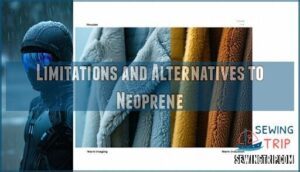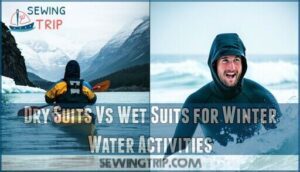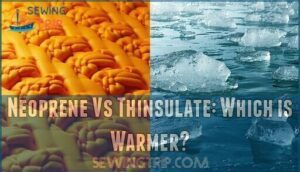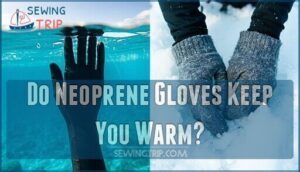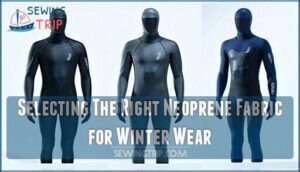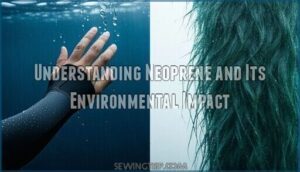This site is supported by our readers. We may earn a commission, at no cost to you, if you purchase through links.

A 5mm wetsuit works well for water sports in temperatures around 43-52°F, while 2mm suits handle milder 62-68°F conditions.
You’ll need boots, gloves, and a hood for complete protection.
However, neoprene isn’t ideal for everyday winter wear since it traps moisture and lacks breathability.
Materials like wool or Thinsulate offer better warmth-to-weight ratios for dry conditions.
Think of neoprene as your go-to for cold water adventures, not your daily winter jacket.
The key lies in understanding when neoprene’s unique properties work best.
Table Of Contents
- Key Takeaways
- Is Neoprene Effective for Winter Warmth?
- Neoprene Thickness and Temperature
- Neoprene Accessories for Added Warmth
- Proper Care and Maintenance of Neoprene
- Limitations and Alternatives to Neoprene
- Dry Suits Vs Wet Suits for Winter Water Activities
- Comparing Neoprene’s Warmth to Other Materials
- Selecting The Right Neoprene Fabric for Winter Wear
- Understanding Neoprene and Its Environmental Impact
- Breathability and Waterproofing of Neoprene Gloves
- Frequently Asked Questions (FAQs)
- Conclusion
Key Takeaways
- You’ll get the best winter warmth from neoprene when you’re in or around water – it’s designed for cold water activities like surfing and diving, not for walking around town or daily winter wear.
- Thickness matters more than anything else for staying warm – you’ll need 5mm neoprene for temperatures around 43-52°F, while 2mm only works in milder 62-68°F conditions.
- You’ll need boots, gloves, and a hood to complete your protection – neoprene loses heat quickly through exposed areas, so accessories aren’t optional if you want to stay truly warm.
- You’ll find better alternatives for dry winter conditions – wool and Thinsulate offer superior warmth-to-weight ratios and breathability compared to neoprene’s moisture-trapping design.
Is Neoprene Effective for Winter Warmth?
Neoprene delivers solid winter warmth through its closed-cell structure that traps air bubbles, creating effective thermal insulation.
This synthetic rubber excels in cold weather conditions down to 30°F, making it ideal for winter activities. Material thickness determines performance—thicker neoprene provides better insulation for extreme cold situations.
While neoprene warmth works well for winter wetsuits and neoprene cold weather gear, layering neoprene with other materials maximizes protection.
However, limited breathability means neoprene alternatives like wool or Thinsulate might suit high-intensity activities better, offering superior moisture management while maintaining warmth, and providing an alternative to neoprene for certain situations.
Neoprene Thickness and Temperature
When choosing neoprene for winter activities, thickness directly determines how warm you’ll stay in different temperature ranges.
The 2mm variety works best in waters between 62-68°F, while the 5mm neoprene provides the insulation you need for colder conditions around 43-52°F.
2mm Neoprene for 62-68°F
Often overlooked in mild cold conditions, 2mm neoprene provides reliable warmth for water temperatures between 62-68°F.
This neoprene thickness offers excellent flexibility factor while maintaining adequate neoprene insulation through its closed-cell structure.
The wetsuit temperature range makes it perfect for active water sports where mobility matters most.
Your activity level substantially influences comfort – high-energy pursuits generate body heat that enhances neoprene warmth.
For extended exposure or lower activity levels, consider layering options like neoprene vests or boots.
Alternative uses include spring suits and shorty wetsuits.
Remember, wetsuit seams affect water entry, maximizing thermal efficiency in these moderate water temperature conditions.
5mm Neoprene for 43-52°F
Moving from milder conditions, 5mm thickness neoprene becomes your go-to choice when water temperatures drop to 43-52°F. This enhanced insulation works by trapping a thicker water layer against your skin, which your body heat warms to create effective thermal protection.
When water hits 43-52°F, your body needs that extra thermal barrier only 5mm neoprene delivers.
While 2mm suits handle warmer waters, cold water diving demands the superior warmth that 5mm thickness provides. The material’s closed-cell structure creates multiple barriers against heat loss, making it the industry standard for wetsuit temperature ranges in this bracket. According to experts, a 4-5 mm wetsuit is suitable for 20°C – 28°C water.
Here’s what makes 5mm neoprene effective for cold water wetsuit applications:
- Thermal Barrier Creation – The thickness traps more insulating water and air pockets
- Sealed Seam Construction – Prevents cold water flush-through that reduces warmth
- Extended Exposure Protection – Maintains core temperature for up to 60 minutes in 50°F water
- Accessory Compatibility – Works with 5mm gloves and boots for complete coverage
The trade-off comes with limited flexibility compared to thinner options. However, for neoprene insulation in genuinely cold conditions, this wetsuit warmth is worth the reduced mobility.
Neoprene Accessories for Added Warmth
You’ll want to maximize your neoprene’s warmth with the right accessories during winter activities.
Neoprene gloves, socks, and strategic layering can extend your comfort range and protect extremities that lose heat fastest in cold conditions, which is crucial for maintaining warmth.
Gloves: Wind-resistant, Liners, Hand Warmers
During cold weather activities, neoprene gloves deliver exceptional hand protection through superior glove wind resistance and thermal insulation. These cold weather gloves maintain glove warmth while preserving glove dexterity for outdoor tasks.
Glove thickness directly impacts thermal performance, with thicker variants offering enhanced protection.
| Feature | 2mm Neoprene | 3mm Neoprene | 5mm Neoprene |
|---|---|---|---|
| Temperature Range | 50-65°F | 40-55°F | 30-45°F |
| Wind Resistance | Good | Excellent | Superior |
| Dexterity Level | High | Medium | Lower |
| Thermal Efficiency | Basic | Enhanced | Maximum |
| Recommended Use | Light activities | Moderate exposure | Extreme conditions |
Neoprene glove liners add an extra thermal lining layer beneath your primary gloves, creating dead air space for improved insulation. For enhanced warmth, consider neoprene glove liners options for added protection.
Neoprene hand warmers can be inserted into glove pockets for additional heat during extended outdoor exposure, making them ideal winter companions.
Socks: Extra Warmth, Protection
Your feet deserve specialized protection during harsh winter conditions.
Neoprene socks provide thermal insulation through closed-cell structure, trapping warm air while managing moisture effectively.
Neoprene sock thickness ranges from 2-5mm for varying cold weather demands.
Activity-specific socks work best for hiking, skiing, or water sports.
Consider sock layering options with thin liners underneath for enhanced winter warmth.
Proper neoprene sock care includes thorough rinsing and drying after use.
Alternative sock materials like merino wool offer different benefits, but neoprene excels in wet conditions.
Consider neoprene winter sock options for ideal foot warmth.
Layering: Added Warmth in Colder Conditions
Maximizing neoprene’s thermal protection requires strategic layering with complementary materials.
Base layers provide essential moisture-wicking properties while neoprene adds insulation. This combination creates superior winter warmth compared to single-layer approaches.
Layering benefits include:
- Base layers – Merino wool or synthetic fabrics wick moisture away from skin
- Insulation importance – Multiple thin layers trap more air than one thick layer
- Activity levels – Adjust layers based on exertion to prevent overheating
- Layering materials – Combine fleece, down, or synthetic insulation with neoprene
- Thermal protection – Create dead air spaces between layers for maximum warmth retention
This layering system adapts to changing conditions while maintaining core temperature during extended winter activities.
Proper Care and Maintenance of Neoprene
Taking care of your neoprene gear isn’t just about making it last longer—it’s about keeping it performing at its best when you need warmth most.
Proper maintenance prevents damage from chlorine, salt, and everyday wear while stopping mold and mildew from ruining your investment.
Rinsing After Chlorine Exposure, Using Gear Aid’s Shampoo
Chlorine exposure wreaks havoc on neoprene, causing color fading and material breakdown that compromises your gear’s thermal performance.
You’ll notice elasticity loss and persistent odors after pool sessions or chlorinated water activities.
Proper rinsing techniques immediately after exposure help minimize chlorine damage by washing away harmful chemicals before they penetrate the material.
Gear Aid’s specialized neoprene shampoo offers superior care compared to regular detergents.
This gentle formula removes chlorine residue while preserving the material’s flexibility and insulation properties.
The shampoo benefits include odor elimination and extended gear lifespan.
For maintenance between deep cleans, mild soap works as an alternative, though dedicated wetsuit cleaners provide better protection.
Neoprene’s comfort is enhanced by its breathable, sweat-wicking design.
Thorough rinsing after each use prevents long-term environmental impact on your neoprene investment, ensuring proper maintenance and a longer gear lifespan with better protection.
Preventing Mold and Mildew Through Thorough Drying and Washing
Proper washing frequency keeps your neoprene gear performing at its peak.
Rinse thoroughly after each use, then wash weekly with mild cleaning agents to prevent bacterial buildup.
Effective drying methods matter most—hang gear in well-ventilated areas away from direct sunlight.
Poor drying creates perfect conditions for mildew growth, compromising neoprene’s insulation properties and shortening its lifespan substantially.
Proper Storage: Clean, Dry, Hang or Lay Flat
After each use, store your neoprene gear in a clean, dry environment.
Hanging benefits include better air circulation and shape retention, while folding effects can create permanent creases.
Choose a well-ventilated storage location away from direct sunlight, and use proper drying methods to prevent mold growth between uses.
Regular cleaning frequency and maintenance extend neoprene’s lifespan, despite its environmental impact limitations.
Limitations and Alternatives to Neoprene
While neoprene works well for water activities, it has clear limitations for everyday winter wear that you should understand.
Better alternatives like wool and Thinsulate often provide superior warmth and breathability for regular cold-weather use.
Wool: Warmer Based on Type and Thickness
When comparing winter materials, wool consistently outperforms neoprene in thermal insulation.
Different Wool Types offer varying warmth levels, with Merino wool providing superior comfort and breathability compared to synthetic alternatives.
Here are five key wool advantages for winter gear:
- Cashmere delivers 7-8 times more warmth than merino per weight due to fine fiber structure
- Thickness Matters substantially – heavyweight wools like Melton excel in subzero conditions
- Moisture Wicking properties keep you dry even when wool absorbs 5% water weight
- Wool Blends combine benefits – angora mixed with merino maximizes insulation
- Thermal insulation values of 0.0324-0.0436 W/(m·K) surpass most synthetic materials
Unlike neoprene’s water-focused design, wool regulates temperature naturally while breathing. This material comparison shows wool’s versatility for dry winter activities, though Wool Alternatives like specialized synthetics may suit specific needs better.
For a breathable and comfortable option, consider cotton and blends.
Thinsulate: Warmer and More Breathable Than Neoprene
When evaluating thermal insulation materials, Thinsulate consistently outperforms neoprene in both warmth retention and breathability comparison. This synthetic insulation delivers nearly 15 times higher thermal efficiency per thickness than neoprene, making it superior for winter conditions.
| Feature | Thinsulate | Neoprene | Advantage |
|---|---|---|---|
| R-value per 0.5" | 2.2 | 0.15 | Thinsulate |
| Moisture wicking | Excellent | Poor | Thinsulate |
| Breathability | High | None | Thinsulate |
| Bulk factor | Low | High | Thinsulate |
Thinsulate Properties include microfibers that trap air while allowing sweat vapor to escape, preventing moisture buildup. Unlike neoprene’s sealed structure, Thinsulate Applications span from boots to jackets without compromising mobility.
Cost Analysis shows that while initially pricier, Thinsulate’s durability and performance justify the investment. For winter activities requiring extended wear, Thinsulate’s superior breathability and Warmth Retention make it the smarter choice over traditional neoprene insulation materials.
Neoprene Better Suited for Water Activities, Not Daily Winter Wear
Neoprene excels in winter water sports but falls short for daily cold weather wear.
Water activity limits become apparent when you step out of aquatic environments, where neoprene’s design truly shines.
Daily wear drawbacks include:
- Poor breathability causing moisture buildup during regular activities
- Bulky thickness reducing mobility for walking and commuting
- Limited style options compared to fashionable winter clothing
- Uncomfortable sweating when switching between indoor and outdoor temperatures
- Difficulty layering with everyday garments effectively
Alternative winter fabrics like wool and fleece offer superior comfort considerations for routine cold exposure, providing better thermal regulation without neoprene breathability issues.
Dry Suits Vs Wet Suits for Winter Water Activities
When you’re planning winter water activities, you’ll need to choose between dry suits and wet suits based on your specific needs.
Dry suits keep you completely dry and allow layering underneath, making them ideal for extended cold-water exposure.
While wet suits rely on a thin layer of trapped water for insulation but offer limited hypothermia protection in prolonged winter conditions, making extended cold-water exposure a critical consideration.
Dry Suits: Breathable, Waterproof, Recommended for Prolonged Winter Water Sports
Beyond neoprene’s temperature limitations, dry suits offer superior protection for extended winter water sports.
These advanced suits maintain complete waterproofing while allowing breathability through technical membranes.
You’ll stay completely dry, enabling strategic winter layering underneath for customizable warmth.
One key aspect of their design is the use of moisture-wicking fabrics to enhance comfort.
| Feature | Dry Suits | Wet Suits |
|---|---|---|
| Water Protection | Fully waterproof | Water enters suit |
| Activity Duration | All-day comfort | Limited exposure |
| Temperature Range | Below 50°F ideal | 43-68°F range |
| Layering Options | Full thermal layers | Minimal underneath |
| Breathability | Up to 8,000g/m²/24h | None |
Professional rescue teams and serious winter water sports enthusiasts choose dry suit types with Gore-Tex or similar breathable membranes.
User reviews consistently highlight their ability to prevent hypothermia during prolonged cold-water activities.
While pricier than neoprene alternatives, dry suits deliver unmatched safety and comfort when winter conditions demand extended water exposure.
Wet Suits: Thermal Insulation When Wet, Limited Protection Against Hypothermia
While dry suits excel in breathability, wetsuits offer different benefits for winter water activities.
These neoprene barriers work by trapping a thin water layer against your skin, which your body heat warms to create insulation.
However, wetsuit thickness and proper fit remain critical factors for hypothermia prevention.
Water entry initially feels cold, but your wetsuit quickly establishes thermal protection.
The snug fit prevents cold water circulation, while layering strategies can enhance winter warmth.
Remember, wetsuits provide thermal insulation when wet but offer limited protection against hypothermia compared to dry suits.
| Feature | 5mm Wetsuit | 3mm Wetsuit |
|---|---|---|
| Temperature Range | 43-52°F | 58-68°F |
| Hypothermia Risks | Moderate protection | Higher risk |
| Fit Importance | Critical for warmth | Essential seal |
Comparing Neoprene’s Warmth to Other Materials
When you compare neoprene to other winter materials like wool and Thinsulate, you’ll notice differences in how each traps heat and keeps you warm.
It’s important to understand these differences so you can choose the best option for your winter activities.
Neoprene Vs Thinsulate: Which is Warmer?
When comparing insulation properties, Thinsulate delivers up to 15 times more warmth than neoprene at equal thickness.
Its microfiber construction traps more air efficiently, while superior breathability comparison shows Thinsulate manages moisture better.
For winter warmth beyond water activity, Thinsulate’s thermal properties excel.
Though cost analysis favors neoprene initially, layering options with Thinsulate provide better long-term value for diverse conditions, offering long-term value and diverse conditions.
Neoprene Vs Wool: Which is Warmer?
When comparing warmth between neoprene and wool, merino wool typically wins for winter warmth on land.
Wool’s natural fibers trap more air than neoprene’s closed-cell structure, providing superior thermal properties in dry conditions.
Here’s how they stack up:
- Wool insulation types – Thick Icelandic wool outperforms synthetic blends, while merino wool offers excellent warmth-to-weight ratios
- Neoprene moisture retention – Excels when wet by trapping water layers, but wool maintains insulation even when saturated
- Activity-specific warmth – Wool dominates for hiking and daily wear, while neoprene shines in water sports
For layering for warmth strategies, wool wins thanks to breathability and comfort.
Cost comparison favors wool for versatility across multiple winter activities.
Are Neoprene Boots Warm?
Your feet stay warm in neoprene boots thanks to their waterproof shell and nitrogen gas bubble insulation.
Boot thickness matters—4mm works for mild cold, while 8mm handles extreme conditions.
Sole insulation prevents ground heat loss, and activity level affects warmth; standing still requires thicker boots than moving around.
Proper fit matters for sealing, and alternative socks underneath boost winter warmth protection.
Do Neoprene Gloves Keep You Warm?
The effectiveness of neoprene gloves in cold weather depends on several key factors that determine their heat retention capabilities.
These gloves work by trapping a thin layer of water against your skin, which your body heat warms to create insulation.
However, their performance varies substantially based on specific conditions and design features.
Neoprene thickness plays a vital role in warmth.
While 2mm gloves offer flexibility for activities requiring dexterity, 5mm options provide superior insulation in harsh conditions.
The trade-off is clear: thicker gloves mean warmer hands but reduced finger mobility.
Water resistance makes neoprene gloves excel in wet environments, but they’re less effective in dry, sub-freezing air temperatures.
Activity type matters too – they’re perfect for kayaking or diving but may disappoint during dry winter hiking.
Glove liners can boost warmth, while alternative materials like fleece or wool might serve you better for purely terrestrial winter activities.
The dexterity impact increases with glove thickness, so choose based on your specific needs.
Selecting The Right Neoprene Fabric for Winter Wear
Choosing the right neoprene thickness depends on your specific winter activities and temperature conditions. You’ll need different insulation properties for different situations, and understanding these factors helps you make the best decision.
Key factors to keep in mind when selecting neoprene:
- Activity type and duration – Water sports require thicker neoprene (5mm) than brief outdoor tasks where 2mm provides adequate winter warmth without bulk.
- Temperature range matching – Match neoprene thickness to expected conditions: 2mm works for 62-68°F, while 5mm handles 43-52°F effectively.
- Fit considerations and layering potential – Proper fit prevents heat loss through gaps. Consider whether you’ll layer underneath, as this affects sizing and overall insulation performance.
Budget options often compromise on quality, but appropriate thickness matters more than premium features for basic winter warmth. The closed-cell structure provides consistent insulation properties regardless of price point, though durability may vary. Focus on getting the right thickness for your temperature range rather than paying extra for features you won’t use.
When sewing your own winter gear, remember that you can use clips instead of pins to avoid damaging the material.
Understanding Neoprene and Its Environmental Impact
While neoprene keeps you warm through its clever air-trapping design, you might wonder about its environmental footprint.
Understanding neoprene’s environmental impact becomes important when you’re choosing between synthetic materials and natural alternatives for your winter gear.
Can Neoprene Be Environmentally Friendly?
Traditional neoprene poses significant environmental challenges, but innovative solutions are emerging.
You’ll find eco-neoprene made from limestone instead of petroleum, reducing manufacturing impact by up to 80%. Recycling neoprene remains difficult due to its chemical structure, though some companies now accept old wetsuits for repurposing into yoga mats and automotive parts.
| Aspect | Traditional Neoprene | Eco-Alternatives |
|---|---|---|
| Raw Materials | Petroleum-based | Limestone/plant-based |
| Biodegradability | Non-biodegradable | Limited improvement |
| Carbon Footprint | High emissions | 80% reduction possible |
| End-of-Life | Landfill waste | Recycling programs |
Sustainable alternatives include natural rubber blends and bio-based foams, though they may sacrifice some thermal performance. While these ecofriendly options reduce environmental drawbacks, you’ll need to balance warmth requirements with environmental consciousness when choosing winter gear.
Why Does Neoprene Break Down?
Your neoprene gear won’t last forever, and understanding why helps you make smarter choices.
UV Degradation from sunlight breaks down neoprene’s molecular bonds, causing it to crack and lose flexibility over time.
Chemical Exposure from pool chlorine, detergents, and cleaning products accelerates this breakdown process substantially.
Saltwater Effects create another challenge.
Salt crystals form during drying, stretching the material and creating tiny tears that weaken the structure.
Storage Issues compound these problems when you stuff wet neoprene into dark, humid spaces where bacteria thrive.
Flex Fatigue occurs through repeated stretching during activities.
Each bend and twist creates microscopic damage that accumulates over months of use.
This breakdown has serious environmental drawbacks – degraded neoprene releases microplastics into waterways.
These limitations mean your winter gear needs regular maintenance and eventual replacement.
Proper rinsing, thorough drying, and careful storage help minimize environmental impact while extending your gear’s lifespan.
Understanding neoprene’s breakdown patterns helps you plan replacements before performance fails.
This understanding is crucial for making smarter choices about your neoprene gear, and for reducing the environmental impact of its degradation.
Breathability and Waterproofing of Neoprene Gloves
When you’re shopping for winter gloves, you’ll want to know if neoprene options can breathe and keep water out.
Understanding these features helps you choose gloves that won’t leave your hands sweaty or soaked during cold weather activities.
Are Neoprene Gloves Breathable?
Most neoprene gloves offer limited breathability due to their closed-cell structure, which traps air for insulation.
While synthetic materials like neoprene excel at warmth retention, they don’t ventilate well during high activity sweat levels.
The lining inside affects comfort versus warmth balance. For cold weather activities requiring better glove ventilation methods, consider alternative breathable gloves with moisture-wicking properties or perforated designs that still maintain adequate protection.
Are Neoprene Gloves Waterproof?
While breathability matters for comfort, you’re likely wondering if your neoprene gloves will actually keep water out.
Most neoprene gloves offer excellent water resistance but aren’t fully waterproof. The material’s closed-cell structure repels moisture effectively for cold weather activities.
Here’s what affects their water protection:
- Seam sealing quality – Poorly sealed seams let water sneak through vulnerable spots
- Waterproof ratings – Higher-rated gloves withstand more water pressure and submersion
- Activity type demands – Industrial gloves prioritize chemical resistance over complete water barriers
Glove liners can add warmth but may compromise the snug fit that enhances water resistance. For serious water activities, look for gloves specifically designed with reinforced seam sealing rather than basic neoprene construction.
Pros and Cons of Neoprene Gloves
While neoprene gloves excel in cold weather and outdoor work, they present trade-offs.
These synthetic insulation champions offer excellent dexterity vs. warmth balance, plus chemical resistance for industrial use cases.
Their flexibility and fit remain superior to bulky alternatives, however, limited breathability causes sweating, and layering options stay restricted.
Industrial gloves using neoprene cost more than basic materials but deliver unmatched waterproof protection.
You’ll sacrifice some comfort for reliable performance in harsh conditions.
Gloves That Are Warmer Than Neoprene Gloves
Several glove types offer superior warmth compared to neoprene options.
Wool gloves provide excellent insulation even when wet, while Thinsulate gloves use synthetic insulation that’s lightweight yet incredibly warm.
Heated gloves feature battery-powered heating elements for maximum warmth.
Down gloves trap air effectively, and fleece gloves with proper lining create multiple insulation layers for cold weather protection.
Many prefer wool for winter due to its warmth and because wool is a great insulator, heated gloves are also an option, and some people like fleece gloves.
Frequently Asked Questions (FAQs)
Can neoprene keep you warm in the winter?
Yes, you can stay warm in winter with neoprene. Its closed-cell structure traps air pockets that block heat loss, keeping you cozy down to 30°F.
Is neoprene wool good for winter?
When you’re looking for winter warmth, neoprene wool blends offer decent insulation through trapped air pockets, but they’re not your best bet for extreme cold compared to dedicated winter fabrics.
What thickness neoprene should I wear in the winter?
Like choosing the right armor for battle, neoprene thickness determines your winter comfort.
You’ll want 3-5mm for moderate cold conditions and 5mm or thicker for extreme winter temperatures below freezing.
Is 5mm neoprene warm?
5mm neoprene delivers solid warmth for temperatures between 43-52°F.
You’ll stay comfortable in cold water since it traps a thin warming layer against your skin, making it perfect for chilly diving conditions.
Does neoprene keep your feet warm?
Neoprene socks absolutely transform frozen toes into cozy companions! The closed-cell structure traps air pockets that insulate your feet, while water-resistance keeps moisture out, maintaining warmth even in cold conditions.
Can neoprene boots be used in winter?
Absolutely, you can wear neoprene boots during winter months. They’re designed to trap heat effectively in temperatures down to 30°F, making them perfect for cold, wet conditions outdoors.
What Are Some Good Winter Sports and Activities Where Neoprene is Useful?
Winter is neoprene’s playground! You’ll find it essential for cold-water surfing, diving, winter swimming, ice fishing, skiing, snowboarding, and kayaking. It keeps you warm and dry during harsh conditions.
Does neoprene keep you warm in winter?
Yes, neoprene keeps you warm in winter by trapping air in its closed-cell structure, creating effective insulation.
It’s water-resistant and works great for temperatures down to 30°F, especially in outdoor activities, utilizing its water-resistant properties.
What temperature is neoprene good for?
You’ll find neoprene effective in temperatures ranging from 30°F to 68°F, depending on thickness.
Thicker 5mm works best for 43-52°F conditions, while 2mm suits handle 62-68°F comfortably for most winter activities, and neoprene is key in these conditions.
Does neoprene insulate cold?
Neoprene’s closed-cell structure traps air pockets that create an insulating barrier, effectively blocking cold from penetrating through.
You’ll stay warmer because it prevents heat loss while repelling moisture that’d otherwise chill you, which is due to its ability to block cold and prevent moisture.
Conclusion
Determining is neoprene warm for winter requires understanding its specific applications.
While 5mm neoprene suits provide excellent insulation for cold water activities around 43-52°F, they aren’t practical for everyday winter wear due to poor breathability and moisture retention.
For dry conditions, wool and Thinsulate materials offer superior warmth-to-weight ratios.
You’ll find neoprene works best as specialized gear for water sports, not general winter clothing.
Choose your insulation based on activity type and environmental conditions.
- https://en.wikipedia.org/wiki/Neoprene
- https://www.franklowe.com/materials/closed-cell-neoprene-rubber/
- https://bwca.com/index.cfm?fuseaction=forum.thread&threadId=1111147&forumID=12&confID=1
- https://buellsurf.com/blogs/wetsuit-guides-1/wetsuit-thickness-guide
- https://www.billabong.com/blogs/expert-guides/wetsuit-thickness-guide





